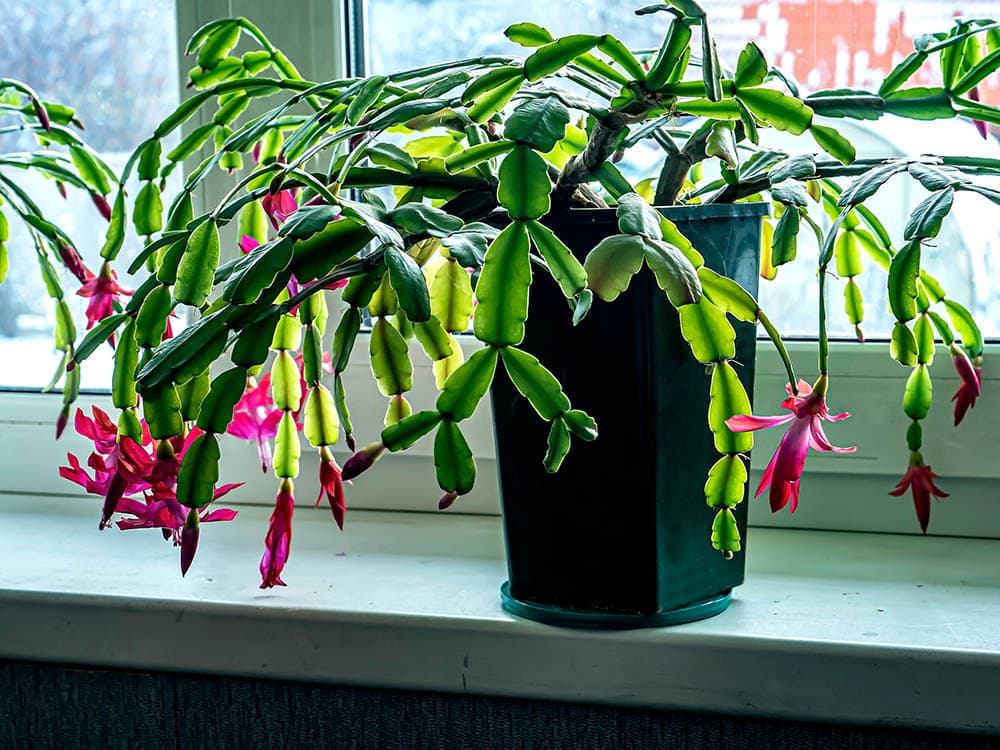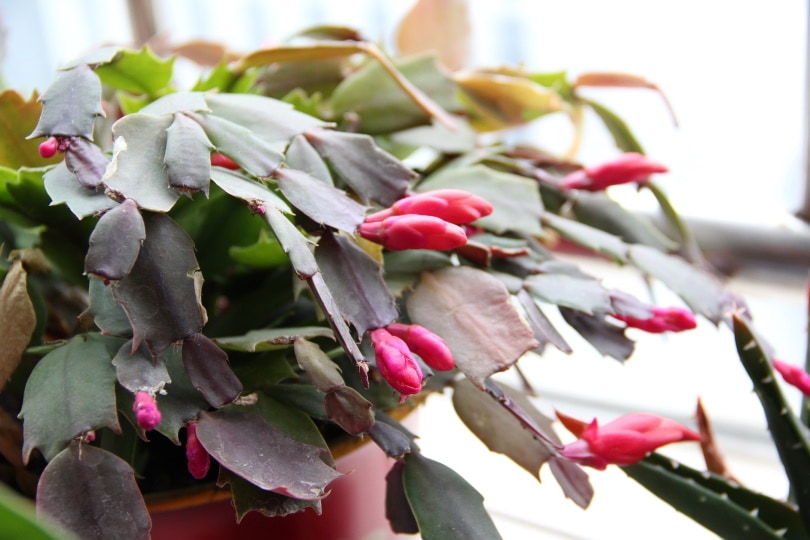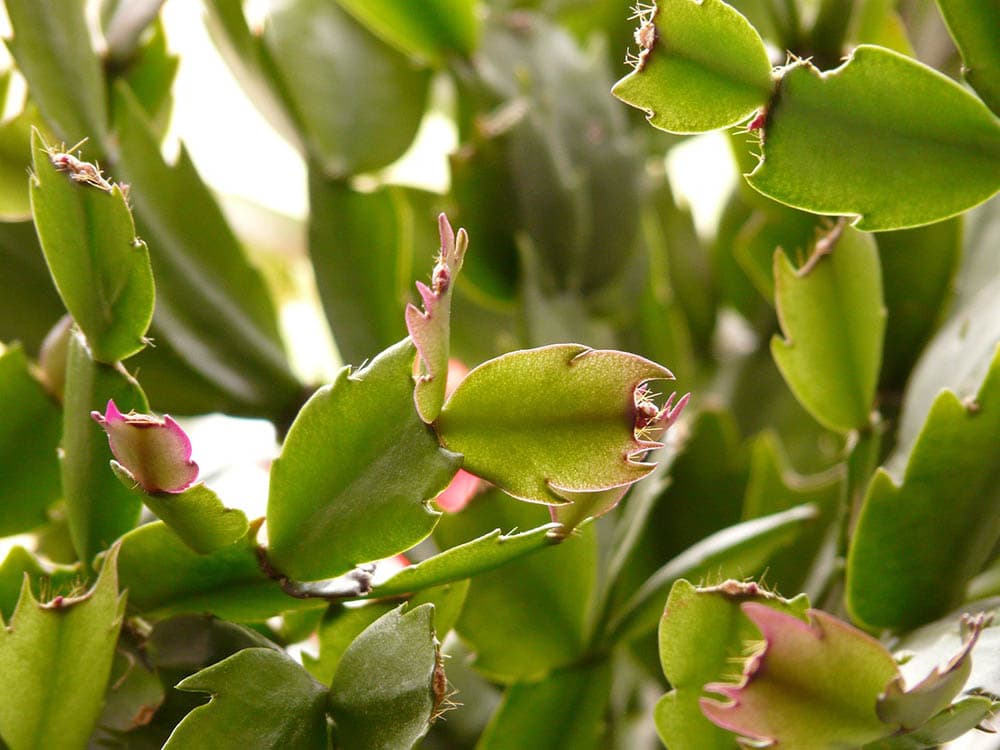Why Are the Leaves on My Christmas Cactus Limp? 6 Possible Reasons
-
Pete Ortiz
- Last updated:

The Christmas cactus is a hardy plant that will thrive on its own, requiring little to no assistance. The scallop-edged plant will grow vibrantly when all is well. But at times, the Christmas cactus limps and falls over due to several reasons.
This article will explore some of the reasons and suggest possible solutions.
The 6 Reasons Your Christmas Cactus Leaves are Limp
1. Inadequate Water

Christmas cacti do not require much water. You only need to water them once or twice a month. In cold rainy seasons, you can extend the time between watering further, provided the potting mixture is wet.
Unfortunately, the long intervals between watering sessions make it easy to forget to water the plant. When deprived of water, plant cells shrink and become flaccid through a process known as plasmolysis. This causes the cacti plant to wilt.
Run your finger through the soil to test for dryness. If more than half of your index finger interacts with dry soil, water the plant. As you water, let the process be as slow as drip irrigation to allow the soil to soak in as much water as possible until excess starts dripping out.
For extremely dry soil
- Fill up a sink and submerge the pot in water for at least 10 minutes. Water will rush through all openings saturating the soil in no time.
- Remove the pot from the sink and let excesses drain out.
- Water the plant again after 2 or 3 days using drip irrigation. If you don’t have a dripping pipe with a nipple, use a plastic bottle with a cap. Make a small hole the size of a 3inch nail on the cap. Fill the bottle with water, tighten the cap and place it upside down near the roots.
- Repeat this procedure a week later and then resume the monthly watering schedule.
2. Overwatering or poor drainage
While lack of water is the direct cause of limping plants, excess water can have the same effects indirectly.
Too much water drives out oxygen from the soil. Plants that are not equipped to deal with such conditions will experience root rot. The problem reduces the surface area for water intake, and plants will go limp. Additionally, damp soil is a good breeding environment for fungi which results in root rot and infections.
But how do you differentiate between dry soil and wet soil limping?
First is looking at the characteristics of the soil, which are easily distinguishable by how moist the soil is. More precisely, you can look at the leaves and roots. Excess water causes yellowing of leaves while the roots soften up and turn brown from cream white. You will notice this after digging down and examining the roots.
- It is certainly impossible to save a plant affected by advanced root rot. But avoid losing your precious cactus by checking the watering frequency and unblocking drainage holes.
- If a couple of roots have started rotting, carefully remove the plant and scrape the soil from the roots. If you see any dark-colored roots, remove them as they are most likely diseased. Proceed to unblock the pot’s drainage holes by poking a stick through them. Repot the plant using high-quality and well-drained potting soil. Finally, water the soil thoroughly, then lightly in the following sessions.
- Note: You should only water the plant when the soil is dry. Otherwise, the risk of overwatering is high.
- To prevent blockages, place an inch-thick layer of gravel before pouring the potting mix into the container. Alternatively, mix the soil with coffee husks to increase aeration.
3. Exposure to direct sunlight

Light is essential for the growth of the Christmas cactus. But because the plant is adapted to moist, shaded forest floors, exposure to direct sunlight may result in limp leaves. It happens by increasing the transpiration rate to a level where the root system cannot take in enough water to balance off.
Prolonged exposure will turn the plant pale, then red, and later brown before dying out.
- Move the Christmas cactus to a bright spot protected from direct sunlight. Outdoors, plant Christmas cactus under a tree or bushy plants. Indoors, remove the plant from places affected by hot, midday sun to close to a screened window.
4. Limping during the blooming season
Blooming is the toughest time for most plants. The process consumes a lot of resources and weakens the plant. In response to the cycle, cactus plants become limp, and one may think they are dying only to revive a few weeks later.
Limping due to blooming is a normal occurrence in Christmas cacti, so there is nothing to be worried about. Just let your cactus plant be. Don’t try to revive it by adding excess water or fertilizer to it. You may slightly increase the watering frequency to aid in flower formation.
5. Pests and diseases

Does your cactus have any suspicious spots? It may be under pest plague. Scale and mealybugs are common cacti pests. They stick on succulent stems and suck in water and juices.
The plant should generally fair well, provided it has enough nutrients and sufficient moisture when accommodating a few pests. However, an attack from thousands is overwhelming, and its least likely cactus will stand tall.
We have talked about root rot as one of the cacti diseases. The plant may also suffer from stem rot, gray mold, and leaf spot.
- Spraying a mixture of insecticides and fungicides kills most insects and disease-causing spores. If the plant is affected beyond recovery, discard it along with the container and spray the area with insecticides and fungicides.
6. Inadequate Light
A cactus will grow limp as it tries to reach well-lit areas. Fix the problem by lifting window blinds for indoor plants. Clear out bushy overhangs and any plant that is competing with the cactus for light in the garden.
Conclusion
Limping is a common problem in cacti and is evident when cells lose more water than they can take in. It is majorly caused by inadequate watering, overwatering, pests and diseases, lack of sunlight, and prolonged exposure to direct sunlight.
Protect cacti against limping problems by observing watering frequency, spraying the plant with insecticides and fungicides, and protecting them from direct sunlight.
- Related Read: 23 Different Types of Toilets: A Complete Overview
Featured Image Credit: alerypetr, Shutterstock
Contents


